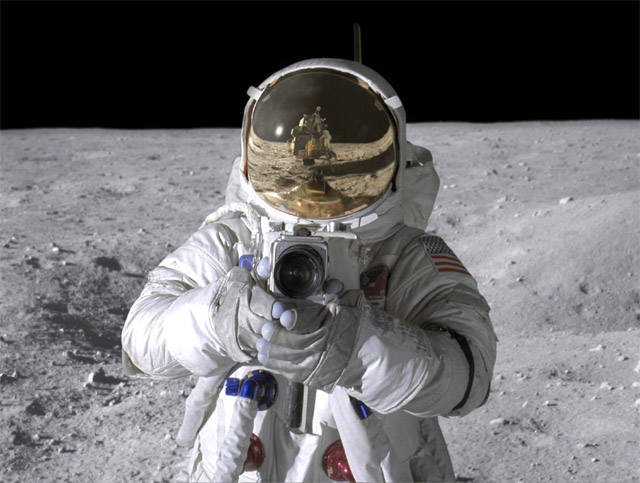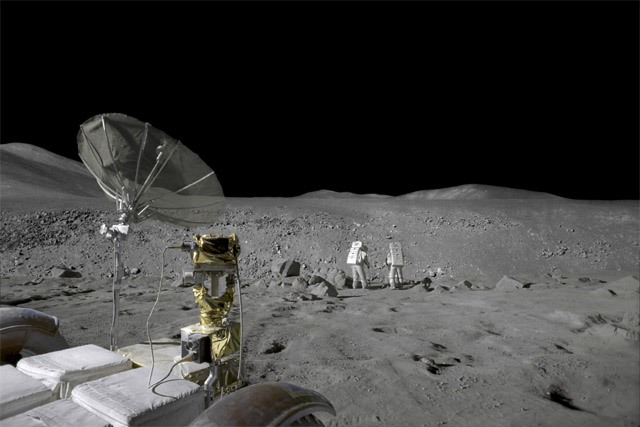|
Exciting news! SynthEyes has joined Boris FX and its award-winning VFX product family. Find out what this means for you. |
SynthEyes Makes Tracks on the Moon in the IMAX Feature "Magnificent Desolation"
* Malvern, PA. October 10, 2005.
The new IMAX™ feature “Magnificent Desolation: Walking on the Moon 3D” takes viewers back to the United States’ lunar landings, using the high-resolution large-screen 3-D format for a compelling lunar experience.
Behind the scenes, the format posed challenges for visual effects providers Digital Dimension and Sassoon Film Design. The large screen necessitated a 4K image resolution, and the 3-D process required that separate images be processed for left and right eyes.
The feature’s new imagery was shot on a stage prepped with a simulated lunar surface and surrounding green screens. Extending the surface to the horizon required adding digital set extensions using 3-D tracking. The astronauts’ highly reflective helmet visors also required tracking to replace reflected crew and equipment with appropriate lunar reflections.

Re-creation of Neil Armstrong, Apollo 11, taking a photo of fellow
astronaut Buzz Aldrin with a Hasselblad still camera, from the IMAX film
"Magnificent Desolation: Walking on the Moon 3D". Re-framed to
show reflection detail. Photo copyright ©2005 IMAX Corporation and
Playtone.
Both Sassoon Film Design and Digital Dimension relied on Andersson Technologies LLC’s 3-D camera tracker, SynthEyes™. As Digital Dimension’s Camera Tracking TD, Travis Yohnke, points out, “Obviously under the IMAX stereoscopic format, tracking accuracy needs to be flawless. When you are looking at a 4k projection, any kind of a slip or a bump will appear like a ketchup stain on a white dress.”
The large image size posed an operational challenge. According to Johnathan Banta of Sassoon, “although SynthEyes was capable of tracking 4K shots, we did so sparingly so as to maximize our speed. 2K and 1K resolutions were the workhorse for most tracking.” Similarly, Digital Dimension usually tracked from lower-resolution frames, moving up to 3K to handle particularly difficult helmet tracks. Due to SynthEyes’ sub-pixel tracking, even 1K proxies could produce accurate tracking for the 4K plates.
Magnificent Desolation’s signature opening shot begins with an extreme close-up of an astronaut’s foot, traveling upwards to the helmet and (replaced) visor. This was the first shot Sassoon handled on the project, and it had to be turned around within two weeks. The ‘inter-ocular distance’ and focus changed throughout, causing minor changes in the field-of-view that were difficult to account for.
Banta describes Sassoon’s approach to handling stereo footage: “Since many of the shots had no scale reference outside the astronaut's helmet, we needed to find some way to set the scale of the resulting SynthEyes output. SynthEyes has the ability to independently track several cameras, but we began reversing the order of the left-eye plates, and appending them to the end of the right-eye sequence instead. The resulting frames were then tracked as one continuous shot. At one point the camera would make a one-frame jump as it shifted from right-eye to left-eye. This ‘inter-ocular distance’ (normally 2.5 inches) can then be reconciled to the known measurement from the notes provided by production, and the scale set there.”
All told, Digital Dimension tracked and delivered about 25 shots in less than 8 months, utilizing the talents of up to 40 artists. Senior VFX Artist Andrew Roberts described their pipeline as follows: “As the film scans came in, they went through a 2D prep phase (lens distortion correction, dust busting, etc.) before tracking could begin. Rotoscoping and wire removal ran in parallel with the creation of digital moonscapes and visors. Compositing, color correction and general sweetening up of the frames came at the end.” Though the shot count is not high compared to a typical blockbuster, due to the nature of the project “the average duration of the tracking shots on Magnificent Desolation was significantly longer compared to any other projects that I have worked on to date,” according to Yohnke, with shots averaging approximately 400 frames. Their longest shot came from the “Future Moon” sequence, in the neighborhood of 800 frames. “Normally these lengths are not an issue, but when you are tracking 2 & 3k frames it’s a different story,” he adds.
Sassoon handled about 50 shots, including the Apollo 11 sequence, the last half of the Apollo 15/Hadley Rille sequence, and the contingency procedure sequence, in less than four months with a team of 6 to 12 artists. The longest was the 1,234 frame opening sequence, which is especially impressive since not only did the background have to be tracked, and two separate astronaut helmets—but each element was tracked in both left and right frames. Some shots of the lunar rover in action required tracking and replacing its antenna, which extended past the top of the green screen, preventing keying. The tracked points from SynthEyes were used in Maya as a basis for photogrammetry, allowing computer-generated extensions to seamlessly blend with the sets. Animation was converted to Electric Image Animation System for final rendering.

Re-creation of Dave Scott and James Irwin, Apollo 15, standing on the edge
of Hadley Rille, a valley nearly a mile wide, from Magnificent Desolation.
Photo copyright ©2005 IMAX Corporation and Playtone.
Based on feedback from the Magnificent Desolation tracking, Andersson Technologies LLC developed RAM-optimization features for its newly-released SynthEyes 2006 Edition to aid future projects. Yohnke wistfully points out that for helmet tracking, “we would have been able to cache the entire shot at one time, making for a smoother, more productive workflow.”
Though a small group of conspiracy theorists have claimed that the 1969 lunar landing footage was faked, Banta remarks that even with today’s modern technology, “we were sorely challenged to match the quality of imagery that actually being on the moon can provide,” adding “Our hats are off to the crews that actually walked on the moon. They think big.”
With NASA now proposing a return to lunar exploration, perhaps Magnificent Desolation can inspire a new generation of young scientists and astronauts to make that possible.
* Pricing and Availability
SynthEyes 2006 is priced at $399 and is available now for PC and Mac. An upgrade to Windows XP 64 Pro adds $200. A CD adds $10 when shipped to the US, or $20 internationally. Quantity and volume educational-institution discounts are available.
A free demonstration version of SynthEyes 2006 is available from the web site.
* The Company
SynthEyes was originally created, developed, and marketed by Dr. Russell Andersson at Andersson Technologies LLC, solving the toughest problems for visual effects professionals for 20 years, with customers in about 100 countries.
In August 2023, SynthEyes was acquired by Boris FX, Inc., under whose auspices it is now being developed and marketed.
* For more information
Boris FX, Inc.
https://www.borisfx.com
sales [at] borisfx [dot] com
SynthEyes, Synthia, and Sizzle are trademarks of Boris FX, Inc.
All other trademarks are the property of their respective owners.
SynthEyes easily is the best camera match mover and object tracker out there.
Matthew Merkovich